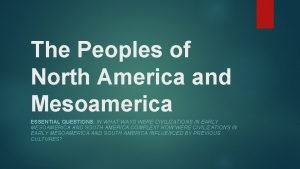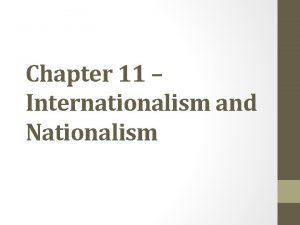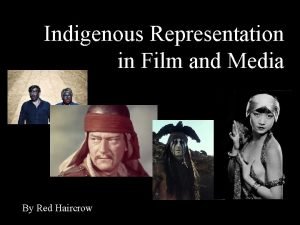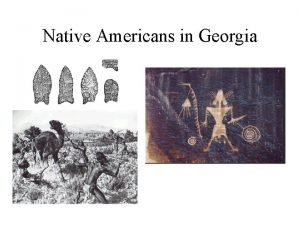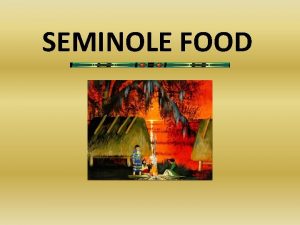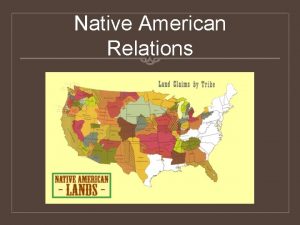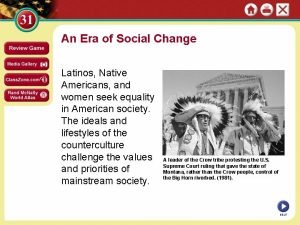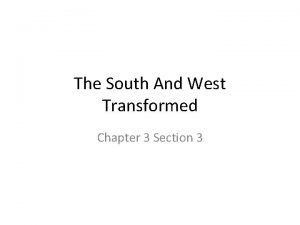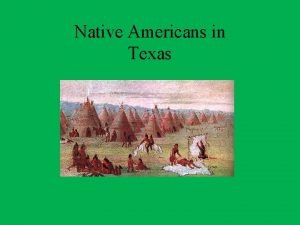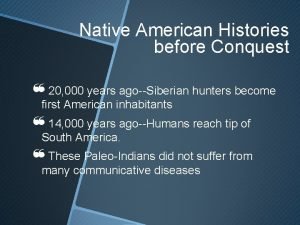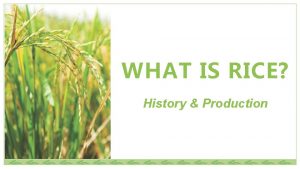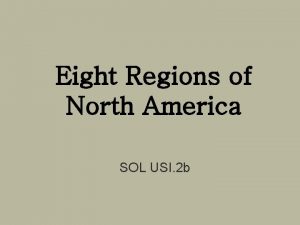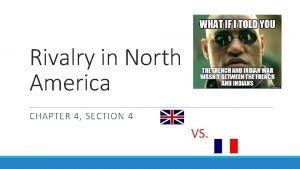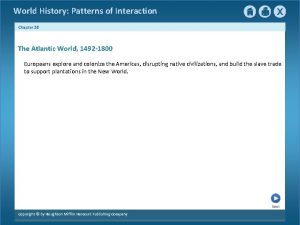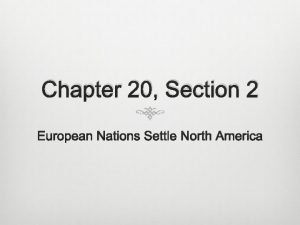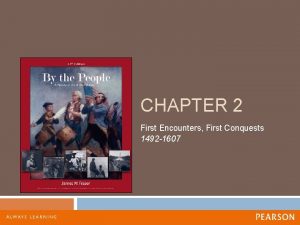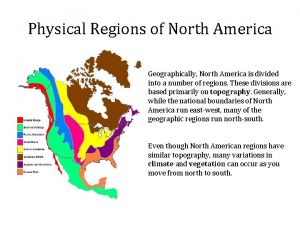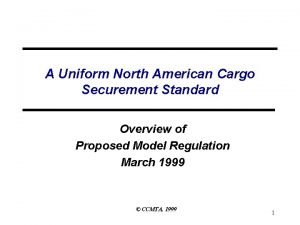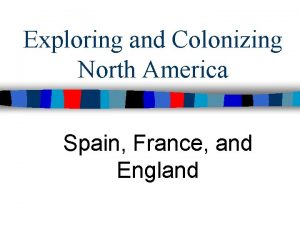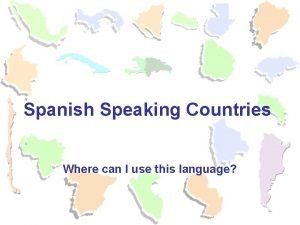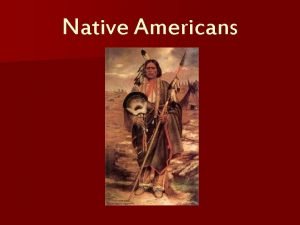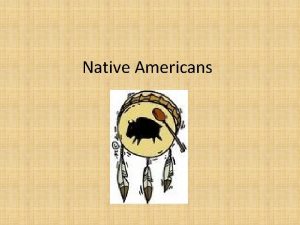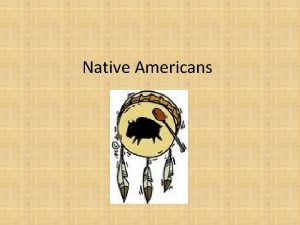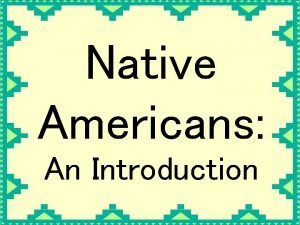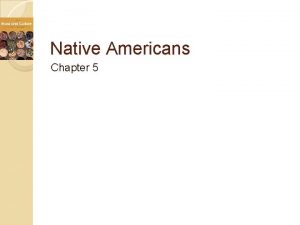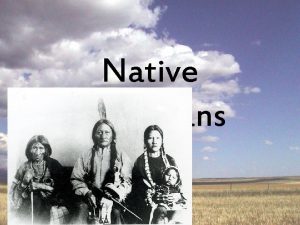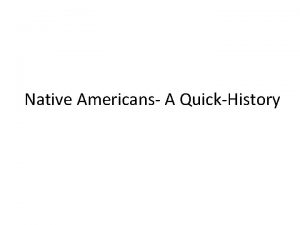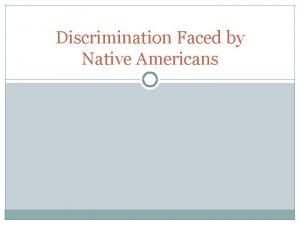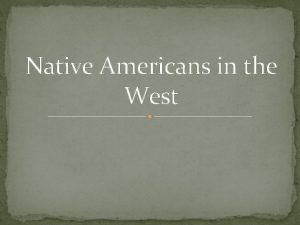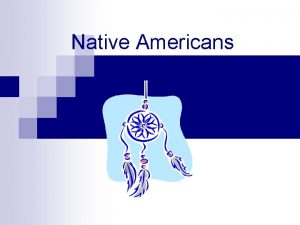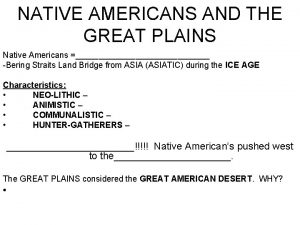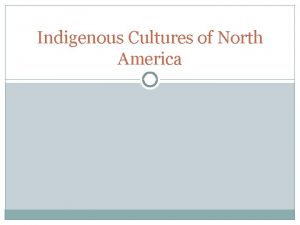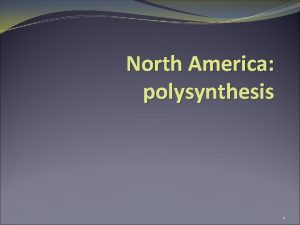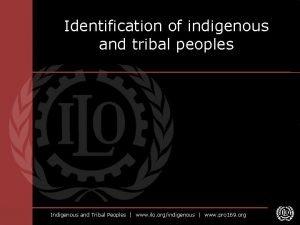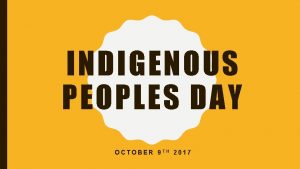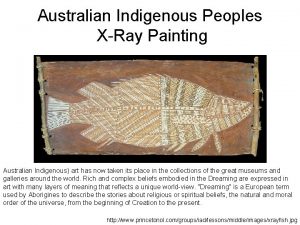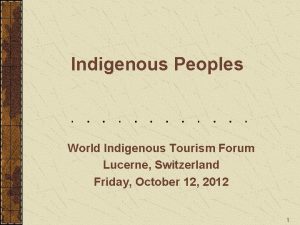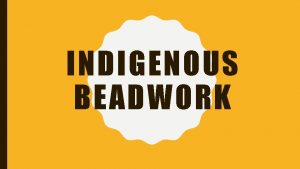INDIGENOUS PEOPLES OF NORTH AMERICA Native Americans QUICK

































- Slides: 33

INDIGENOUS PEOPLES OF NORTH AMERICA Native Americans

QUICK! • Someone raise your hand tell me the oldest Native American / indigenous peoples fact or story you know

The Clovis People • In the 1930 s, archaeologists discovered spear points in the New Mexico town of Clovis, dated at around 13, 000 years old. • The 'Clovis first' theory proposes that around 14, 000 years ago people travelled across a land bridge that existed between Siberia and Alaska. • More recent fossil finds question theory. • Some researchers believe the first people entered North America as long as 20, 000, 30, 000, or 50, 000 years ago

The Shaping of North America • Recorded history began 6, 000 years ago. It was 500 years ago that Europeans set foot on the Americas to begin colonization • The theory of Pangaea exists suggesting one mega -continent. • Continental Drift not only separated the continents but created geologic wonders.

Unfathomable numbers • 13. 2 Billion Years (Let’s divide everything by 1 billion) • If the Universe began 13 Years Ago, then… • the earth would have existed for about 5 years (4. 5 billion) • large multi-celled organisms for 7 months (600 milllion) • the mega asteroid occurred 3 weeks ago (67 million) • bipedal hominids would existed just 3 days ago (7 million) • Homo Sapiens first appeared 53 minutes ago (200, 000) • agrarian societies have been in practice for 5 minutes (10, 000) • the entire recorded history of civilization for 3 minutes (~5, 000) • modern industrial societies for 6 seconds (250) • the 1 st humans in space just 1 second ago (50)

Geological Changes • 10 million years ago North America was shaped by nature • Canadian Shield: First landmass above sea level • 2 million years ago Great Ice Age • 35, 000 years ago the sea level dropped leaving an isthmus connecting Asia and North America (Bering Strait) • 10, 000 years ago ice started to retreat and melt which once again covered the land bridge from the Old World to the New World

The Land Bridge: 17, 000 -50, 000 Years Ago • People hunted and gathered for food. As their food sources became scarcer they started looking for ways to hunt larger animals. • The largest animals moved across the Bering Strait into what would become North America. • The Bering Strait was exposed land was not under water. • The Ice Fields in the northern parts of North America soaked up all the water. • People followed the herds across the Bering Strait and then into North America. As the ice fields melted, the people spread south. • Evidence for this theory includes pieces of pottery, hunting tools and various other artifacts in the shallow water of the Bering Strait. • Also, the people of various native groups in North America can have similar DNA patterns to native peoples in north Asia.

Coastal Theory: 12, 000 -50, 000 Years Ago • People who propose this theory claim that North America was reached via sea travel close to shore lines. • Some evidence also exists to show that early humans may have “island hopped” to find their way into South America then moved into North America. • Evidence for this theory includes a common design in floating vessels such as canoes and boats. • There is also some geologic evidence in the shallow waters off the BC coast. • The western Canadian coastline is also evidence of this theory in all of its various islands.

The Paleo-Indian Period • The time of the Clovis people is marked by larger than life game and innovative discovery. • The American Mastodon, Folsom Projectile, Hunting the Glyptodon

Folsom Environment

Folsom Points • The Folsom tool kit maintained many of the characteristics of the previous Clovis tradition. • The new projectile points had thinner blades and were smaller, possibly in response to the efficiencies of bison hunting or to facilitated hafting to a spear point.

Tools 1. 2. 3. 4. 5. 6. Antler awl used to make hide clothing. Bone needle used to sew hide for shoes and clothing. Hammerstone used to make stone tools Chert knives used to process meat. Scrapers used to clean hides. Fluted projectile points used to hunt. 1 3 2 4 6 5

Megafauna • Paleo-Indians hunted large mammals called mega-fauna, most of which are now extinct. • They followed herds of these big-game animals from place to place, hunting in groups. • Because of the danger, men hunted while women raised children and gathered wild plant foods like nuts and berries

Sabertooth Cat (Smilodon fatalis) Height: 4 ft (1. 2 m) Lived: 1. 5 million years ago

Shortfaced Bear (Arctodus simus) Height: 5. 5 ft (1. 7 m) Lived: 800, 000 years ago

Dire Wolf (Canis dirus) Height: 5 ft (1. 5 m) Lived: 1 million years ago

Giant Ground Sloth (Eremotherium laurillardi) Height: 20 ft (6 m) Lived: 8 million years ago

American Mastodon (Mammut americanum) Height: 9 ft (2. 75 m) Lived: 15 million years ago

Woolly Mammoth (Mammuthus primigenius) Height: 9 ft (2. 75 m) Lived: 90, 000 years ago

North American Bison (Bison antiquus) Height: 7 ft (2. 1 m)

REGIONAL INDIGENOUS SOCIETIES

Indigenous Peoples in the Classic and Post-Classic Era • Throughout the Classic and Post-Classic Mesoamerican period Native American life grew and adapted at a very accelerated rate. • ~0 -1000 CE • ~1200 -1500 CE • Variation of Indigenous Peoples based in part on interactions with the environment and each other: … • Social Structures • Matriarchal and Patriarchal • Political Structures • Treaties, leaders • Economic & Societal Organization • Welfare Systems • Tool and Weaponry Innovation • Etc.

Significance of Maize • Probably domesticated in the Tehuacan Valley of Mexico • Original form long extinct, could no longer exist as a wild plant in its present form, started as a wild grass cultivated into maize, originally had only 8 rows of kernels • Originally used by Mayan, Aztec, Incas, (all in Mexico) and some Pueblo (southwest US) • Allowed families to live in one place, but time commitment to development was significant

Significance of Maize • Maize slowly began to move north, arriving in New England about 1, 000 years ago, and up to the St. Lawrence • First product that could afford a surplus and therefore be stored, sold, and traded allowing for a more complex and advanced economy in native societies • Husks often used to produce other goods (bags, shoes, etc. ) • Arrival of corn explains much about the rate of development of different Native societies; nationstates (such as Mayan and Inca) only really available once the mass crop is available

Prior To Contact: The Southwest • The Natives of the Southwest were divided into two groups some were hunter/gathers and some were farmers. • The Pueblos were skilled farmers (maize) • These Pueblos used irrigation canals to bring water for their farming. • The Apache and Navajo entered the southwest around 1500 and were hunter-gatherers. • Permanent, apartment-like dwellings • Pueblo villages were self-governing, run by a governing chief • Known for making beautiful pottery and baskets Archetypal group: Pueblo (village in Spanish)

Prior To Contact: Northwest Coast • The Native Americans of the Northwest had no need to farm, but they were not nomadic. Archetypal group: Chinook • The land was full of animals; the sea was full of fish. Most of the villages were located near the Ocean. • Wood was plentiful, and the natives of the areas used the woods to build longhouses, home to up to 50 people. • One of the unique innovations of the Indigenous Peoples of the Northwest was the large canoe that could hold 50+ people. • They were carved out of redwoods. • Very stratified society – caste system, upper class warriors and shamans, segregated groups and even children • Practiced slavery (used other Natives) • Head flattening for children (flatter head = higher social status) Lewis/Clark Journal

Prior to Contact: Southeast • Agricultural villages, 200 each with 30 -60 houses and a counsel house (made of branches and mud) • “three-sisters” farming: corn, beans, squash) • Also hunter-gatherer • Leadership would change according to circumstance. Red leaders (war) or White leaders (peace) • Villages only met for ceremonies or war Archetypal group: Cherokee

Prior to Contact: Great Basin Archetypal group: Ute • Travel and camp in familiar sites, created specific trails, namely the Ute Trail • As hunter gatherers, movement allowed site to replenish • Both men and women hunted (women=smaller game) • Also gathered wild plants to supplement nutrition • Bear dance in spring after winter rest

Prior To Contact: The Plains • Sioux tribe consisted of Dakota, Nakota, and Lakota • The Plains stretch from the Mississippi River to the Rocky Mountains. • The areas had large herds of buffalo which provided abundant food. Archetypal group: Dakota Sioux

Prior to Contact: Mississippi Mound Builders Archetypal group: Cahokia • Cahokia Mound Site in STL • Large urban center for mound building cultures of the Midwest/Mississippi • Home to up to 40, 000 people at height, with surrounding farm communities • Waste and lack of food made for difficult living • Large mound build over centuries 10 stories tall, nearby plaza for game playing and social activities • Mounds were used for burials or ceremonies. Homes were made of surrounding materials.

Prior To Contact: Northeast Archetypal group: Iroquois Lived in area rich in rivers and forests • The Iroquois, led by Hiawatha and Deganawidah, created the only real North American empire outside Mexico/Peru: Iroquois Confederacy • • group of 5 tribes (Mohawks, Oneidas, Onondagas, Cayugas, Senecas) in New York state Main function was defense Each tribe kept their independence, but met occasionally to discuss matters of common interest. They were matrilineal, men dominated society, but owed positions to their wives’ family’s prominence • Economies: mixed hunter-gatherer and agricultural, sedentary • Long houses up to 200 ft. long w/ up to 5 fireplaces for 2 families

Making Contact

Eric Foner – Pgs 17 -20 Red Heading to Red Heading • • • To what extent did Indigenous and European ideas of freedom differ on the eve of contact? Indian Freedom Christian Liberty Freedom and Authority Liberty and Liberties The American Spirit – Pgs 1 -9 Document Category A. • • How might we explain the attitudes of Renaissance era Europeans toward the newly discovered Indians? Was the concern for Christianizing the Native Americans sincere?
 Similarities between inca maya and aztec
Similarities between inca maya and aztec The peoples of north america and mesoamerica
The peoples of north america and mesoamerica World council of indigenous peoples
World council of indigenous peoples Indigenous peoples
Indigenous peoples Where did native americans come from
Where did native americans come from Traditional seminole indian food
Traditional seminole indian food How many native americans died on the trail of tears
How many native americans died on the trail of tears Latinos and native americans seek equality
Latinos and native americans seek equality What three circumstances hurt native americans
What three circumstances hurt native americans Coahuiltecan tattoos
Coahuiltecan tattoos Native americans
Native americans America vs africa
America vs africa Quick find algorithm
Quick find algorithm 1.7.6 - quick check: frost quick check
1.7.6 - quick check: frost quick check First people in the world
First people in the world Rice native to america
Rice native to america Repetition in let america be america again
Repetition in let america be america again Why is it called latin america
Why is it called latin america Happening body art
Happening body art America america you mean the world to me
America america you mean the world to me Eight regions of north america
Eight regions of north america Define british north america act
Define british north america act Lesson 4 rivalry in north america
Lesson 4 rivalry in north america Chapter 20 section 2 european nations settle north america
Chapter 20 section 2 european nations settle north america Ing north america insurance corporation
Ing north america insurance corporation European nations settle north america chapter 20 section 2
European nations settle north america chapter 20 section 2 Spanish north america
Spanish north america Physical regions of north america
Physical regions of north america Indirect tie down
Indirect tie down Fort duquesne apush
Fort duquesne apush North america, family histories, 1500-2000
North america, family histories, 1500-2000 Icpc north america
Icpc north america The colonial class system
The colonial class system North america countries
North america countries

